
Common Sense Backcountry Travel
I just finished reading Aron Ralston's book, "Between a Rock and a Hard Place." If you recall, Ralston was a highly accomplished mountain climber and backcountry traveler who suffered a freak accident while canyoneering in Blue John Canyon in Utah. He was coming down over a boulder, the boulder rolled and pinned his right arm. After being pinned several days in the canyon, Arron ended up having to cut his right arm off above the wrist with the equivalent of a Leatherman tool in order to save his life. It is a very good read. Ralston is clearly smart and very articulate. He also writes in a brutally honest fashion, probably indicative of the sort of personality it takes to cut one's arm off to save one's life. Ralston is also pretty candid about the hubris that lead him to go out that morning, on a road trip where he told no one where he was going, either generally (like, what state) or specifically (which canyon). In retrospect, Ralston admits that hubris triumphed over common sense that day, and it nearly cost him his life.
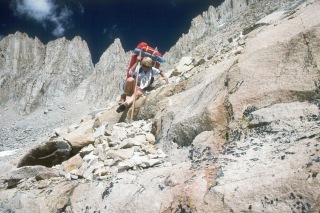 This article was inspired and suggested by my former spouse Sunny, who is now busy living in Silverthorne, CO, and climbing fourteeners. I had emailed her and a bunch of other active hikers, concerning an article that I will be doing on the use of maps in the backcountry. (More specifically, WHY they aren't used more.) Sunny wrote back right away with some thoughtful comments on the subject, but essentially said: you could do a real service to just write about making sure people exercise common sense when they are out in the wilderness. I thought about it for a bit, and agreed that such an article was overdue on this web site. I guess much of the stuff below will seem both straightforward and obvious. But then, if such is so obvious, why don't more people follow these simple guidelines? Hey, I only minored in Psychology.
This article was inspired and suggested by my former spouse Sunny, who is now busy living in Silverthorne, CO, and climbing fourteeners. I had emailed her and a bunch of other active hikers, concerning an article that I will be doing on the use of maps in the backcountry. (More specifically, WHY they aren't used more.) Sunny wrote back right away with some thoughtful comments on the subject, but essentially said: you could do a real service to just write about making sure people exercise common sense when they are out in the wilderness. I thought about it for a bit, and agreed that such an article was overdue on this web site. I guess much of the stuff below will seem both straightforward and obvious. But then, if such is so obvious, why don't more people follow these simple guidelines? Hey, I only minored in Psychology.
A few comments before I get to the meat of the issue. If we just limit the analysis to backcountry in the United States, we are still considering an exceedingly huge range of circumstances, climatic conditions, elevations, and distance from roads. Even in the Lower 48, it is more than just a long physical distance from the swamps of the Everglades to the upper slopes of Mt Rainier. They seem MORE than a world apart, and thus, it is impossible to cover every situation, and clearly some guidelines and behaviors appropriate to, for example, the Citico/Joyce Kilmer/Slickrock Wilderness in the southern Appalachians will be inappropriate for the slickrock canyons of Southern Utah. But with the increasing mobility in our society, it is likely that serious backcountry travelers will find themselves in the circumstances discussed below more than once in their lives. So, on with the obvious.
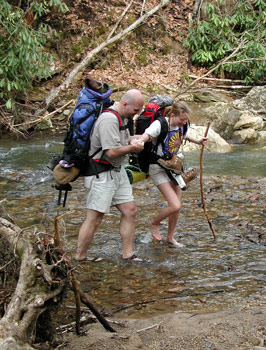 1. Think about your route before you leave. Even if you are not leading the hike, backpack, sea kayak, etc., it will always pay to spend a bit of time considering where you are going. How much elevation gain and distance will there be? Is it reasonable to leave the trailhead at 11 am in mid-October for a day hike (with emphasis on "day") that will cover 15 miles, half of which will be off-trail travel? (The right answer is likely "no," but the question is more important.) Who will be accompanying you? Will they likely want to move faster or slower than you? How will you deal with the speed differences? Will there be any special conditions you will likely encounter? Stream crossings in early season can be life threatening if you are unprepared. Will wildlife be an issue on the route? (Around Bozeman, we always carry bear spray, as grizzlies have been sighted in the mountain areas just south of town. But here is a hint: if you bring bear spray with you to the trailhead, don't leave it in the car on a summer day. One woman in a group of hikers that Susie routinely hikes with did, and the canister exploded inside the car. Cleaning bill: well north of $2000.) Water and how much you need to carry is always a concern, because dehydration can be a problem. Now, people who live in the Southeastern US reading this will smile, because the only water problems there are typically having too much, by way of rain or high stream crossings. But many areas west of the Hundredth Meridian can get pretty thirsty on a warm day. Even for a day hike around Bozeman, in the summer time, I will often carry three liters of water if I will be hiking meadows and ridges.
1. Think about your route before you leave. Even if you are not leading the hike, backpack, sea kayak, etc., it will always pay to spend a bit of time considering where you are going. How much elevation gain and distance will there be? Is it reasonable to leave the trailhead at 11 am in mid-October for a day hike (with emphasis on "day") that will cover 15 miles, half of which will be off-trail travel? (The right answer is likely "no," but the question is more important.) Who will be accompanying you? Will they likely want to move faster or slower than you? How will you deal with the speed differences? Will there be any special conditions you will likely encounter? Stream crossings in early season can be life threatening if you are unprepared. Will wildlife be an issue on the route? (Around Bozeman, we always carry bear spray, as grizzlies have been sighted in the mountain areas just south of town. But here is a hint: if you bring bear spray with you to the trailhead, don't leave it in the car on a summer day. One woman in a group of hikers that Susie routinely hikes with did, and the canister exploded inside the car. Cleaning bill: well north of $2000.) Water and how much you need to carry is always a concern, because dehydration can be a problem. Now, people who live in the Southeastern US reading this will smile, because the only water problems there are typically having too much, by way of rain or high stream crossings. But many areas west of the Hundredth Meridian can get pretty thirsty on a warm day. Even for a day hike around Bozeman, in the summer time, I will often carry three liters of water if I will be hiking meadows and ridges.
2. Pack the Ten Essentials This is the most obvious rule about backcountry travel there is. But I would be willing to bet that half of the hikers, mountain bikers, cross country skiers violate this rule repeatedly. I will discuss the issue of maps in a future article, but I wanted to focus on one of the Essentials here in more detail, based on a couple of recent experiences.
Virtually all lists of the Ten Essentials include "extra clothing." Sometimes, especially when the heat and humidity combine for a sweltering day, the concept of "extra clothing" feels pretty ridiculous. "Clothing optional" is a concept that comes to mind instead. Well, Susie was on a day hike a while ago in the northern end of the Gallatin Range, just south of Bozeman, MT. The forecast was highs in the low 80's (in the valley) with a chance of thundershowers late in the afternoon or early evening. Yeah, you're right: by lunchtime, it was raining on the hikers, and Susie, with the "rain gear" part of the Ten Essentials in her day pack, pulled out her rain parka and proceeded on. But she admitted when she returned home that afternoon that she had gotten pretty cool, because, while she had rain gear with her, she had not taken a fleece top to provide some extra insulation under the parka. And .... (You KNEW I was going to say this) many of the people with whom she was hiking did not even have rain jackets with them. Did they, like, think these things are too heavy to carry on a day hike, or what?? Who knows - I only minored in Psychology.
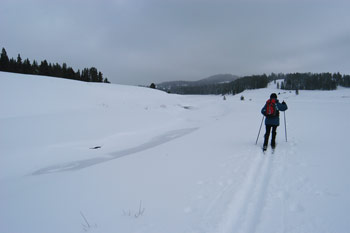 But extra clothing can mean different things in different circumstances. This was running through my head as Susie and I were backcountry skiing on a day outing in the NW corner of Yellowstone early last January. The Fan Creek drainage is just lovely at this (and most any other) time of year. The snow can be pretty deep, and there are enough terrain nuances to make things interesting. As we had skied up the valley, the breeze had started to pick up and we headed for the trees for a lunch break. We put on down parkas, and heavy mittens. I measured the temperature at 16 degrees F, but the chill factor had to be close to zero. For those of you who have skied under these conditions (yeah, I know, pretty mild), you can appreciate how fast your mittened hands get cold while you are trying to sip hot cider and munch on a sandwich. But running through my mind was this: would the extra clothing we had with us be sufficient to keep one of us warm who might have smashed the front of their tibia breaking through a snow bridge and sliding their ski and boot under a now-exposed root or downed log? At the time, we were about 2 - 3 hours from the car, and probably another 30 - 45 minutes to get to any kind of civilization where a cell phone might work. Since there were only two of us, one person would have to go for assistance while the one with the broken leg would be left, since hauling the injured party out without the aid of several people would be very difficult. I know that some people will say: build a shelter, start a fire, etc. All good ideas. But floundering around in waist deep snow to find small pieces of firewood, build a fire area (it does not work very well to try to build a fire on top of deep snow) all consumes precious time that might be devoted to getting the injured party out. Something to ponder.
But extra clothing can mean different things in different circumstances. This was running through my head as Susie and I were backcountry skiing on a day outing in the NW corner of Yellowstone early last January. The Fan Creek drainage is just lovely at this (and most any other) time of year. The snow can be pretty deep, and there are enough terrain nuances to make things interesting. As we had skied up the valley, the breeze had started to pick up and we headed for the trees for a lunch break. We put on down parkas, and heavy mittens. I measured the temperature at 16 degrees F, but the chill factor had to be close to zero. For those of you who have skied under these conditions (yeah, I know, pretty mild), you can appreciate how fast your mittened hands get cold while you are trying to sip hot cider and munch on a sandwich. But running through my mind was this: would the extra clothing we had with us be sufficient to keep one of us warm who might have smashed the front of their tibia breaking through a snow bridge and sliding their ski and boot under a now-exposed root or downed log? At the time, we were about 2 - 3 hours from the car, and probably another 30 - 45 minutes to get to any kind of civilization where a cell phone might work. Since there were only two of us, one person would have to go for assistance while the one with the broken leg would be left, since hauling the injured party out without the aid of several people would be very difficult. I know that some people will say: build a shelter, start a fire, etc. All good ideas. But floundering around in waist deep snow to find small pieces of firewood, build a fire area (it does not work very well to try to build a fire on top of deep snow) all consumes precious time that might be devoted to getting the injured party out. Something to ponder.
3. Consider the Need or Desire for communications capability. One of the most basic communications devices (and the simplest, cheapest, and lightest) is a whistle. I always carry one in my miscellaneous gear bag. But of course, it will only do one some good (usually) if you are hiking (skiing, biking, etc) with others. A whistle is a good way of calling attention to oneself if there are people in the vicinity. And, it may help rescuers looking for you if you can not yell or are otherwise incapacitated.
What about walkie-talkies? Some people swear by them, especially when groups of hikers, climbers, etc, get strung out over long distances. Sunny relates an incident when a climbing partner of hers fell off a ridge crest, and survived the fall. Fortunately, he had a walkie-talkie with him, and was able to alert his partners as to his need for assistance and location. Clearly, in some circumstances, they can have their place.
Before I make some comments about portable ham radios, cell and satellite phones that may be interpreted as being anti-technology, let me just say that most people who know me well would not consider me a techno-phobe. In our home, we have seven computers running on our network (for two people), four of which I built myself. Back in Knoxville, we were one of the very first adopters of a high speed internet connection, and I consider myself reasonably proficient in the use of GPS. I even OWN a cell phone. But typically, I don't carry it into the backcountry. Why? Well, probably lots of factors are involved. I know some people enjoy reaching the summit of a peak or ridgeline and calling a friend or relative to note their accomplishment. Our good friend Will Skelton has even called us from balds in the Southern Appalachians on a Saturday night, chiding me that he was out backpacking and we were sitting home. I think for those kinds of uses, cell phones are fine, but it is not my style.
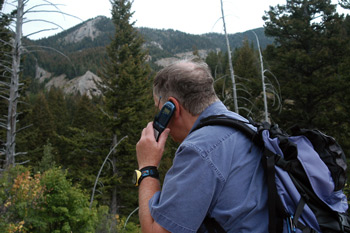 What I concern myself with is that some individuals will rely on the two-way communication with the outside world that a cell or satellite phone provides to compensate for a lack of experience, a marginal set of backcountry skills (such as map reading), or an inability to cope with the inevitable small problems that occur during backcountry travel. Our friend Ray Payne volunteers weekly at the Backcountry Permit desk in the prime visitor center for the Great Smoky Mountains National Park, and hears a number of stories. One that speaks to this issue involved a young woman backpacking at the eastern end of the Park along the Appalachian Trail. She was in a shelter, no more than 5 miles from a trailhead. While making her morning coffee, she spilled some hot water on her pants, and got some second degree burns on her thigh. Now, most of the backpackers that I hike with would have cussed a bit, put some salve on the burned area, and continued with their trip. In contrast, the young woman called the Park HQ (she was having an understandably difficult time getting a connection on her cell phone) and wanted to be evacuated!!! For someone like me, who derives a great deal of satisfaction from the self-reliance that comes from backcountry travel, the idea of calling anyone in all but the most extreme emergency is an anathema. Part of where I am coming from on this issue is that there are risks, albeit small ones, involved in backcountry travel. If one does not feel comfortable accepting those risks, then maybe (with emphasis on this word) one should consider doing something different for outdoor recreation. People have asked me how a GPS can be OK, but a cell phone is not something I want to carry. The answer is the difference between uni-directional communication and bi-directional communication. The GPS is a receiver, and you have to know something about it, and be able to read a map to be able to use it. A cell phone lets you talk to a human being. (Hence their popularity.) That is why to me, philosophically, these emergency locator subscription services (such as you might have seen Ralston a current spokesman for in ads in Backpacker or Outside magazine) fit the bill if you are really concerned about injury or want to backpack or climb mountains by yourself. You are not likely to use them in all but the direst emergency.
What I concern myself with is that some individuals will rely on the two-way communication with the outside world that a cell or satellite phone provides to compensate for a lack of experience, a marginal set of backcountry skills (such as map reading), or an inability to cope with the inevitable small problems that occur during backcountry travel. Our friend Ray Payne volunteers weekly at the Backcountry Permit desk in the prime visitor center for the Great Smoky Mountains National Park, and hears a number of stories. One that speaks to this issue involved a young woman backpacking at the eastern end of the Park along the Appalachian Trail. She was in a shelter, no more than 5 miles from a trailhead. While making her morning coffee, she spilled some hot water on her pants, and got some second degree burns on her thigh. Now, most of the backpackers that I hike with would have cussed a bit, put some salve on the burned area, and continued with their trip. In contrast, the young woman called the Park HQ (she was having an understandably difficult time getting a connection on her cell phone) and wanted to be evacuated!!! For someone like me, who derives a great deal of satisfaction from the self-reliance that comes from backcountry travel, the idea of calling anyone in all but the most extreme emergency is an anathema. Part of where I am coming from on this issue is that there are risks, albeit small ones, involved in backcountry travel. If one does not feel comfortable accepting those risks, then maybe (with emphasis on this word) one should consider doing something different for outdoor recreation. People have asked me how a GPS can be OK, but a cell phone is not something I want to carry. The answer is the difference between uni-directional communication and bi-directional communication. The GPS is a receiver, and you have to know something about it, and be able to read a map to be able to use it. A cell phone lets you talk to a human being. (Hence their popularity.) That is why to me, philosophically, these emergency locator subscription services (such as you might have seen Ralston a current spokesman for in ads in Backpacker or Outside magazine) fit the bill if you are really concerned about injury or want to backpack or climb mountains by yourself. You are not likely to use them in all but the direst emergency.
Are their times when carrying a cell or satellite phone is acceptable to me? Yeah, I think so. On Our Alsek River trip, the guides carried a satellite phone, and I am sure that it was used to coordinate the helicopter-assited portage around Turnback Canyon. Our friends and I carried two small marine radios with us on a sea kayaking trip in Prince William Sound in Alaska. We did so because there was one part of the trip where we had to cross open ocean (albeit a short distance). Being on water is simply not as comfortable for me as being on solid ground. I think we ended up turning them on just once, to listen to a weather forecast. Some folks feel that when the get really deep into backcountry (such as the bowels of Gates of the Arctic National Park), a satellite phone is mandatory. Maybe so, as long as I don't have to carry it. Would I use it in case of emergency? Sure, but I would feel badly about it. At the end of our 2002 Beartooths backpacking trip, when one of our party broke her leg, we talked about whether it would have been useful to have a satellite phone with us. We agreed that it would have been, but only so we did not have to screw up our backpack and could keep on with our projected route. Sorry Sue. Have a nice flight out, but we got some hiking to do here. Heck, I felt badly about abandoning her in our hotel room in Cody, Wyoming. I an not sure I could have left her at Green Lake so that we could have continued on with our fun. So call me a purist. But then I am sure that John Muir would have just shaken his head and felt similarly about all the GoreTex and goose down and titanium stoves and GPS units that I carry when I backpack or day hike. So maybe I am just old fashioned.
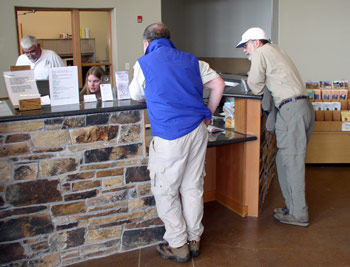 4. Tell someone where you are going. This was the major mistake that Ralston made. He probably still would have lost his arm (since it was pinned against a huge boulder, and no circulation for even a few hours may result in the loss of a limb), but he might not have come anywhere near as close to losing his life. For organized trips, I usually put together a draft hiking itinerary. But even a simple call or email (I think the latter is better, because someone will have something in writing to which to refer) to a friend or relative is a good idea, if you are not headed out with a group of people. Include the trailhead you are going to hike or ski from, where you are headed, and when you expect to be back. It certainly would not hurt to let them know a time by which, if they have not heard from you, to call the authorities. I confess that I do not follow this rule all the time. But Susie and I usually do if we are off on a backpack or cross country ski by ourselves. If you are going to be out for a few days, drop a copy of your proposed itinerary at the ranger station if you happen to pass one. If there is a trailhead register, use it. But as with most everything in life, there are no guarantees. There was an interesting, albeit tragic, story of a 48 year old experienced backpacker, in the June 2002 issue of Backpacker magazine, traveling with only his dog as his companion, off trail in the Wind River Mountains in 1998. He had given his wife a description of the route he was taking, a planned 9-day sojourn through "The Winds." On fourth day out, while boulder-hopping around an unnamed lake, the man was a victim of a freak boulder-roll, that pinned both of his legs above the knees. He survived for over a week, but not long enough for a search party to find him. Sometimes, the dragon wins.
4. Tell someone where you are going. This was the major mistake that Ralston made. He probably still would have lost his arm (since it was pinned against a huge boulder, and no circulation for even a few hours may result in the loss of a limb), but he might not have come anywhere near as close to losing his life. For organized trips, I usually put together a draft hiking itinerary. But even a simple call or email (I think the latter is better, because someone will have something in writing to which to refer) to a friend or relative is a good idea, if you are not headed out with a group of people. Include the trailhead you are going to hike or ski from, where you are headed, and when you expect to be back. It certainly would not hurt to let them know a time by which, if they have not heard from you, to call the authorities. I confess that I do not follow this rule all the time. But Susie and I usually do if we are off on a backpack or cross country ski by ourselves. If you are going to be out for a few days, drop a copy of your proposed itinerary at the ranger station if you happen to pass one. If there is a trailhead register, use it. But as with most everything in life, there are no guarantees. There was an interesting, albeit tragic, story of a 48 year old experienced backpacker, in the June 2002 issue of Backpacker magazine, traveling with only his dog as his companion, off trail in the Wind River Mountains in 1998. He had given his wife a description of the route he was taking, a planned 9-day sojourn through "The Winds." On fourth day out, while boulder-hopping around an unnamed lake, the man was a victim of a freak boulder-roll, that pinned both of his legs above the knees. He survived for over a week, but not long enough for a search party to find him. Sometimes, the dragon wins.
5. Leave something in your vehicle that rescue dogs could use to pick up your scent. This was a suggestion that Sunny passed along from a Search and Rescue course she took. I usually wear moccasins when driving to the trailhead and change into my hiking boots after I arrive. If the search animal could survive sniffing my moccasins, maybe he or she could use it to track me. Another idea: leave a copy of your itinerary in your vehicle, in case you are overdue. It makes it easier for a potential search team to narrow your location.
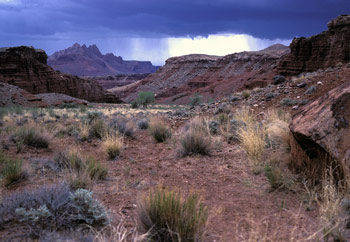 6. Be sensitive to changing conditions, and respond accordingly. Changing conditions can refer to a variety of things, from your own physical stamina or status, changing weather, or changes in the route. For example, a warm spring day can rapidly swell a stream by increasing the rate of snow melt. A modest creek can turn into a torrent rapidly. When hiking in tight drainages like canyons, be aware of the possibility of flash flooding. I have never been caught in a flash flood, but I recall one evening along the lower Paria River in northern Arizona. We had spent a good chunk of the afternoon up in a side canyon, visiting, among other things, Wrather Arch. On the way back, it started to rain and rain hard for a couple of hours. We got back to our campsite for the night, and fixed dinner, chatting until well after nightfall. Suddenly, there came a wall of noise moving down canyon. We all got up and ran over to the bank of the river, just in time to see the water rise 18 inches, right before our eyes. It was an impressive sight, and a reminder of why one needs to be vigilant.
6. Be sensitive to changing conditions, and respond accordingly. Changing conditions can refer to a variety of things, from your own physical stamina or status, changing weather, or changes in the route. For example, a warm spring day can rapidly swell a stream by increasing the rate of snow melt. A modest creek can turn into a torrent rapidly. When hiking in tight drainages like canyons, be aware of the possibility of flash flooding. I have never been caught in a flash flood, but I recall one evening along the lower Paria River in northern Arizona. We had spent a good chunk of the afternoon up in a side canyon, visiting, among other things, Wrather Arch. On the way back, it started to rain and rain hard for a couple of hours. We got back to our campsite for the night, and fixed dinner, chatting until well after nightfall. Suddenly, there came a wall of noise moving down canyon. We all got up and ran over to the bank of the river, just in time to see the water rise 18 inches, right before our eyes. It was an impressive sight, and a reminder of why one needs to be vigilant.
Weather, or weather-related phenomena, are usually associated most frequently with rapid change in the backcountry. But other things can happen quickly. On a cold winter day, breaking through a snow bridge and going into the water can turn a quiet backcountry ski into a rapidly deteriorating, potentially life threatening situation. Or a simple day hike on a hot, dry day can turn catastrophic if one of the parties is not taking in sufficient water. One of my cardinal rules is to not be afraid to throw in the towel and turn around, or modify your goal if things become too challenging. I recall an off-trail backpack my friend Ray and I set out on one early November weekend. We really wanted to follow this creek drainage in the Great Smoky Mtns Nat'l Park. Things were going ok, albeit slow and tough for a while. Fighting dense vegetation can be pretty tiring. I recall, as it got later into the afternoon, Ray and I were crawling on our bellies through what is affectionately referred to in that part of the country as a "rhododendron hell." Now crawling on your belly through slushy, three day old snow, dragging a fifty pound pack behind you is simply not as much fun as it sounds. We were both getting really tired, and under those conditions, it would be really easy to hurt oneself (assuming one could find a spot sufficiently un-vegetated so one could stand up and fall). And if we kept up this pace, we would never make it to camp before dark. Trying to hike off trail, after dark, even WITH the flashlight that you brought as part of the Ten Essentials is definitely NOT what you want to be doing. Ray rolled his head back toward me and said: "You know, it is getting a little brushy in here." We both wisely agreed that although we both really wanted to follow the creek, common sense dictated that we take a path of lesser resistance along the ridge. We did, and made it to our proposed campsite right before dark. The smart thing to do.
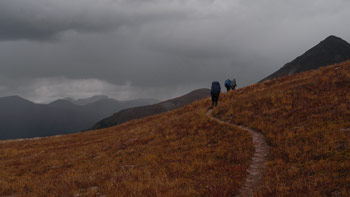 7. Pay attention when thunderstorms threaten. I guess if you do enough hiking or climbing, especially in the mountains, you are going to encounter thunderstorms. They can be pretty neat, or pretty scary, depending on your perspective. While I have experienced many of these violent storms, a spot along the Continental Divide trail in Colorado's Weminuche Wilderness below the formation they call the Window holds a special place in my heart. In 1981, my then-fiancé Sunny and I were backpacking, and a big thunderstorm just pounded us right below the Window. Fast forward 24 years and a few months later. Susie and I, along with our friends Tim and Diane, are on a 4 day backpack in mid-September. You guessed it: it was late in the day, and we decided to set up our tents with an approaching hail storm right near the Window. Sure enough, we were treated to the ultimate light and sound show. Tim reported that one bolt of lightening struck so close to him that he could smell the resulting ozone in the air. When you are that exposed, lightening can be very scary. One of the recommendations one frequently reads for these situations is to get off the ridge or the peak on which you stand. That is great advice, if you can pull it off. But there are many trails in the western mountains where you can simply not descend safely off the ridge in either direction. In the Southern Appalachians, sometimes the vegetation along the side of the trail is so thick that it is impractical to drop significantly off the ridge.
7. Pay attention when thunderstorms threaten. I guess if you do enough hiking or climbing, especially in the mountains, you are going to encounter thunderstorms. They can be pretty neat, or pretty scary, depending on your perspective. While I have experienced many of these violent storms, a spot along the Continental Divide trail in Colorado's Weminuche Wilderness below the formation they call the Window holds a special place in my heart. In 1981, my then-fiancé Sunny and I were backpacking, and a big thunderstorm just pounded us right below the Window. Fast forward 24 years and a few months later. Susie and I, along with our friends Tim and Diane, are on a 4 day backpack in mid-September. You guessed it: it was late in the day, and we decided to set up our tents with an approaching hail storm right near the Window. Sure enough, we were treated to the ultimate light and sound show. Tim reported that one bolt of lightening struck so close to him that he could smell the resulting ozone in the air. When you are that exposed, lightening can be very scary. One of the recommendations one frequently reads for these situations is to get off the ridge or the peak on which you stand. That is great advice, if you can pull it off. But there are many trails in the western mountains where you can simply not descend safely off the ridge in either direction. In the Southern Appalachians, sometimes the vegetation along the side of the trail is so thick that it is impractical to drop significantly off the ridge.
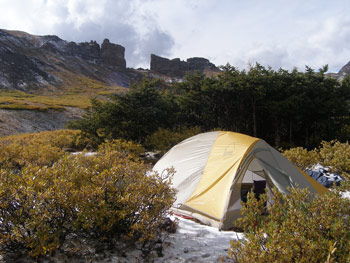 So what does one do? Well, probably a good thing to do is to avoid hiking in high mountains in the afternoon. Especially during "monsoon" season. Start hiking early if you can, so you can set your camp up somewhere other than at a highly exposed site early in the afternoon. If you see a storm coming and you feel pretty exposed, if possible, move quickly to a place where you are no longer the most obvious exposed point around. Susie and I used this successfully in ‘99 while hiking the Continental Divide Trail in the Weminuche. You hear the advice all the time: don't get under a tree during a lightning storm. Well, that is great advice if one's concept of wilderness is the rough on the 14th hole. But if you are hiking most places in the eastern US, it is hard to NOT be under a tree. Same goes for the lower elevations of the west. So some good advice when the time span between lightning flashes and thunder is less than about 6 seconds (meaning that the lightning is about a mile away or less) is to keep moving. And the same thing goes for times when you are exposed on a treeless ridge: keep moving, since it reduces the probability that static charges will build up on your body, and that you become the primary attraction, shall we say. Obviously, if you are wearing a metal framed pack, ditch it for the duration of the storm. And when out in the open, move in a direction so as to put something higher than you near, but not too close, alongside you. And if the situation has deteriorated to the point where the hair on your or one of your partners is standing up, hit the ground fast, since it is a sign that major static charges are building up on one of you, and you are about to become a human lightning rod.
So what does one do? Well, probably a good thing to do is to avoid hiking in high mountains in the afternoon. Especially during "monsoon" season. Start hiking early if you can, so you can set your camp up somewhere other than at a highly exposed site early in the afternoon. If you see a storm coming and you feel pretty exposed, if possible, move quickly to a place where you are no longer the most obvious exposed point around. Susie and I used this successfully in ‘99 while hiking the Continental Divide Trail in the Weminuche. You hear the advice all the time: don't get under a tree during a lightning storm. Well, that is great advice if one's concept of wilderness is the rough on the 14th hole. But if you are hiking most places in the eastern US, it is hard to NOT be under a tree. Same goes for the lower elevations of the west. So some good advice when the time span between lightning flashes and thunder is less than about 6 seconds (meaning that the lightning is about a mile away or less) is to keep moving. And the same thing goes for times when you are exposed on a treeless ridge: keep moving, since it reduces the probability that static charges will build up on your body, and that you become the primary attraction, shall we say. Obviously, if you are wearing a metal framed pack, ditch it for the duration of the storm. And when out in the open, move in a direction so as to put something higher than you near, but not too close, alongside you. And if the situation has deteriorated to the point where the hair on your or one of your partners is standing up, hit the ground fast, since it is a sign that major static charges are building up on one of you, and you are about to become a human lightning rod.
When you do set up camp, if you have a choice, pick a spot that might have an obvious peak or wall close by, but not too close. That way, maybe the peak will attract the lightning, and not your tent. If you are in tentia for the night, and a bad storm makes it feel like the end of the world is nigh, you might consider making sure that you are sitting completely on your foam sleeping pad, and no part of you is in contact with the tent floor. This is so that if the tent or surroundings does get hit, there is a lesser chance that the full force of the electricity will pass through your body. I know it all sounds pretty brutal, but so can being struck by lightning.
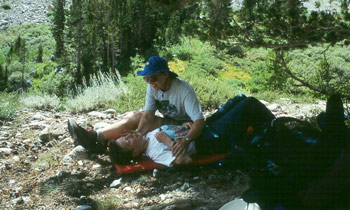 8. Consider taking a course in Wildness Emergency Medicine. WEM is vastly different than Red Cross First Aid training (I know. I have taken courses in both.) Most "first aid" courses can be distilled down to "Stop the bleeding and call 911." Such is fine for the city or front country situations, and the training is a very useful use of your time. But, if you think about it, in the backcountry, there is no 911. You fix it yourself, or not at all. WEM courses (I have taken a two-day course and a one-day refresher) focus on assessing the extent of injuries, making hard choices about what you can and can not accomplish, stabilizing any injuries, and basically, getting a person to the point where you can leave him or her (ideally with another member of your party) for several hours to a day or two, in order to effect a rescue (if self-rescue is not possible or practical). WEM can teach you to think about what you should carry with you, and how to use what you might have with you to splint broken extremities, etc. Yes, you will learn some first aid, but don't expect to be taught about how to use bedsheets and boards to make a split for a broken leg. And don't expect to learn CPR (cardio-pulmonary resuscitation) in a WEM course. With perhaps the exception of a lightning strike or potential immersion to the point of near drowning situation, there are few examples where cardiac collapse can be managed successfully in the backcountry. Put a bit less delicately, if you do suffer a heart attack in the backcountry, it may be time to bend over and kiss your ass goodbye. The shear amount of energy required to perform CPR is simply not sustainable for hours on end. And if you don't feel like you can devote about the same amount of time to a course as you might spend on a weekend backpack, at least buy a copy and READ "Medicine for Mountaineering" published by Mountaineers Books (the Mountaineers are an outings group based in Seattle). And, it is a good book to have around the house anyway.
8. Consider taking a course in Wildness Emergency Medicine. WEM is vastly different than Red Cross First Aid training (I know. I have taken courses in both.) Most "first aid" courses can be distilled down to "Stop the bleeding and call 911." Such is fine for the city or front country situations, and the training is a very useful use of your time. But, if you think about it, in the backcountry, there is no 911. You fix it yourself, or not at all. WEM courses (I have taken a two-day course and a one-day refresher) focus on assessing the extent of injuries, making hard choices about what you can and can not accomplish, stabilizing any injuries, and basically, getting a person to the point where you can leave him or her (ideally with another member of your party) for several hours to a day or two, in order to effect a rescue (if self-rescue is not possible or practical). WEM can teach you to think about what you should carry with you, and how to use what you might have with you to splint broken extremities, etc. Yes, you will learn some first aid, but don't expect to be taught about how to use bedsheets and boards to make a split for a broken leg. And don't expect to learn CPR (cardio-pulmonary resuscitation) in a WEM course. With perhaps the exception of a lightning strike or potential immersion to the point of near drowning situation, there are few examples where cardiac collapse can be managed successfully in the backcountry. Put a bit less delicately, if you do suffer a heart attack in the backcountry, it may be time to bend over and kiss your ass goodbye. The shear amount of energy required to perform CPR is simply not sustainable for hours on end. And if you don't feel like you can devote about the same amount of time to a course as you might spend on a weekend backpack, at least buy a copy and READ "Medicine for Mountaineering" published by Mountaineers Books (the Mountaineers are an outings group based in Seattle). And, it is a good book to have around the house anyway.
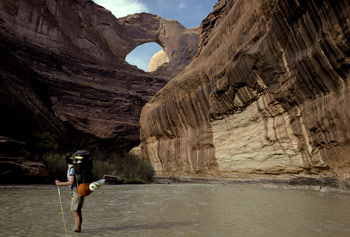 9. Never hike alone? Note the question mark. You hear this advice all the time. Sometimes I follow it and sometimes I don't. Like all things in life, the associated risks come with rewards: solitude, self reliance, going at no one's pace but your own, etc etc. If you need something to inspire you, pick up a copy of Walking with the Wild Wind, by the late Walkin' Jim Stoltz. Stoltz captures, better than any other book I have ever read, the true aspects of solo backcountry travel. I don't want to put off anyone by saying that he really captures the spiritual side of solo backpacking, but such is really true. His manuscript gets to the heart and the gut. If you need assistance articulating why you do or want to do this sort of thing, Stoltz's book is an absolutely must-read. In fact, I would have to say it is a must read for any backpacker. It will speak to you, for sure.
However, many people see hiking, (or skiing or mountain climbing) solo as an unacceptably high risk. But as humans, we tend to elevate the level of unfamiliar risks, and diminish, at least subconsciously, the level of familiar risks. If I were feeling in a particularly contentious mood, I might argue that the distraction that comes from having other people in the car with you as you drive to the trailhead represents a much greater risk to one's life and limb (and those of the others in the vehicle) than hiking or skiing by oneself. But of course, we all have some level of comfort, and I would supposed it is reasonable to use as a guideline the avoidance of being uncomfortable when one is in the backcountry. I certainly identified my comfort level 16 years ago, while backpacking off trail in the Olympic Mountains above Royal Basin: if I expect that there is a significant chance that I will have to actually use my ice axe for self arrest, while backpacking solo, then maybe I ought to consider another route. You can make up your own guidelines, but it is a useful exercise to understand where your comfort zone might be. Clearly, some people will feel a bit uncomfortable just WATCHING grizzly bears fishing on a TV show. Then, there are the Timothy Treadwells of the world. There has got to be a happy medium. Find yours.
9. Never hike alone? Note the question mark. You hear this advice all the time. Sometimes I follow it and sometimes I don't. Like all things in life, the associated risks come with rewards: solitude, self reliance, going at no one's pace but your own, etc etc. If you need something to inspire you, pick up a copy of Walking with the Wild Wind, by the late Walkin' Jim Stoltz. Stoltz captures, better than any other book I have ever read, the true aspects of solo backcountry travel. I don't want to put off anyone by saying that he really captures the spiritual side of solo backpacking, but such is really true. His manuscript gets to the heart and the gut. If you need assistance articulating why you do or want to do this sort of thing, Stoltz's book is an absolutely must-read. In fact, I would have to say it is a must read for any backpacker. It will speak to you, for sure.
However, many people see hiking, (or skiing or mountain climbing) solo as an unacceptably high risk. But as humans, we tend to elevate the level of unfamiliar risks, and diminish, at least subconsciously, the level of familiar risks. If I were feeling in a particularly contentious mood, I might argue that the distraction that comes from having other people in the car with you as you drive to the trailhead represents a much greater risk to one's life and limb (and those of the others in the vehicle) than hiking or skiing by oneself. But of course, we all have some level of comfort, and I would supposed it is reasonable to use as a guideline the avoidance of being uncomfortable when one is in the backcountry. I certainly identified my comfort level 16 years ago, while backpacking off trail in the Olympic Mountains above Royal Basin: if I expect that there is a significant chance that I will have to actually use my ice axe for self arrest, while backpacking solo, then maybe I ought to consider another route. You can make up your own guidelines, but it is a useful exercise to understand where your comfort zone might be. Clearly, some people will feel a bit uncomfortable just WATCHING grizzly bears fishing on a TV show. Then, there are the Timothy Treadwells of the world. There has got to be a happy medium. Find yours.
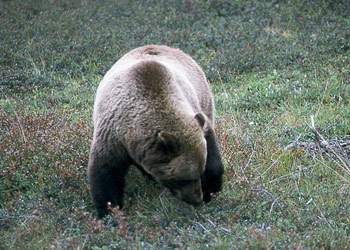 10. Do some mental exercises when you are in the backcountry. When you are not chatting with friends or companions, think about possible scenarios, and how you would deal with them. For example, what would I do if a) the leader was hit on the head by a falling tree limb and was knocked unconscious, or had a heart attack, or broke a leg; b) a hiker was overcome by heat or dehydration; c) one of you lost his or her balance, and slid down a long, exposed slope, or d) was struck by a rattlesnake or a hive of yellow jackets; or d) began showing the signs of altitude sickness or hypothermia. Can you recognize the signs of hypothermia before it becomes to late - in yourself or others? (On a cold winter backpack, I once had a young woman come over to my tent, sit down and start taking her clothes off, saying she was so HOT, and I was pretty convinced it was NOT due to my animal magnetism!) Do you know how to read a map sufficiently well that if the leader becomes incapacitated, you can locate your position and/or find your way out of the backcountry? What would you do if, 15 seconds from now, you turned the corner and found yourself 30 yards from a grizzly eating a dead deer? How would you handle the situation if 10 of you are out day hiking, strung out over maybe a quarter mile, and two of the group do not show up at the next planned rest stop? It never hurts to think these sorts of things through before they really happen.
10. Do some mental exercises when you are in the backcountry. When you are not chatting with friends or companions, think about possible scenarios, and how you would deal with them. For example, what would I do if a) the leader was hit on the head by a falling tree limb and was knocked unconscious, or had a heart attack, or broke a leg; b) a hiker was overcome by heat or dehydration; c) one of you lost his or her balance, and slid down a long, exposed slope, or d) was struck by a rattlesnake or a hive of yellow jackets; or d) began showing the signs of altitude sickness or hypothermia. Can you recognize the signs of hypothermia before it becomes to late - in yourself or others? (On a cold winter backpack, I once had a young woman come over to my tent, sit down and start taking her clothes off, saying she was so HOT, and I was pretty convinced it was NOT due to my animal magnetism!) Do you know how to read a map sufficiently well that if the leader becomes incapacitated, you can locate your position and/or find your way out of the backcountry? What would you do if, 15 seconds from now, you turned the corner and found yourself 30 yards from a grizzly eating a dead deer? How would you handle the situation if 10 of you are out day hiking, strung out over maybe a quarter mile, and two of the group do not show up at the next planned rest stop? It never hurts to think these sorts of things through before they really happen.
I appreciate the fact that many folks who hike, ski, climb, whatever, simply like to be outside, engaged in some sort of self-propelled activity, enjoying the scenery, wildlife, etc, while leaving most of the heavy duty planning and thinking to the leader/s. I enjoy such myself. But ultimately, in the backcountry, everyone is responsible for themselves. As Sunny concluded in the original note to me that inspired this article: To just get people to think about these things is great. Most people don't think anything bad will happen, but as you and I know, something always happens. And how right she was: I look back on the past 30 years or so of my own experiences in the backcountry, and the number of times that something occurs that one might wish did not happen is not trivial. Whether it is bad weather that can make a marginal situation worse, broken limbs (and I don't mean those of trees), wildlife encounters, or getting lost, the application of forethought, planning, and common sense often meant the difference between tragedy, and the ability to reflect back over an "interesting adventure." Stay alive and in one piece to tell the stories to your grandkids.
© Roger A. Jenkins, 2000, 2001, 2006, 2015; Tent and phone photos © Suzanne A. McDonald, 2006; Visitor center photo © William H. Skelton, 2005